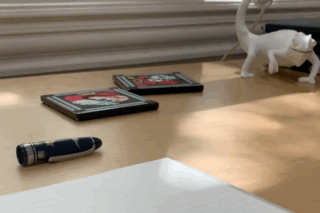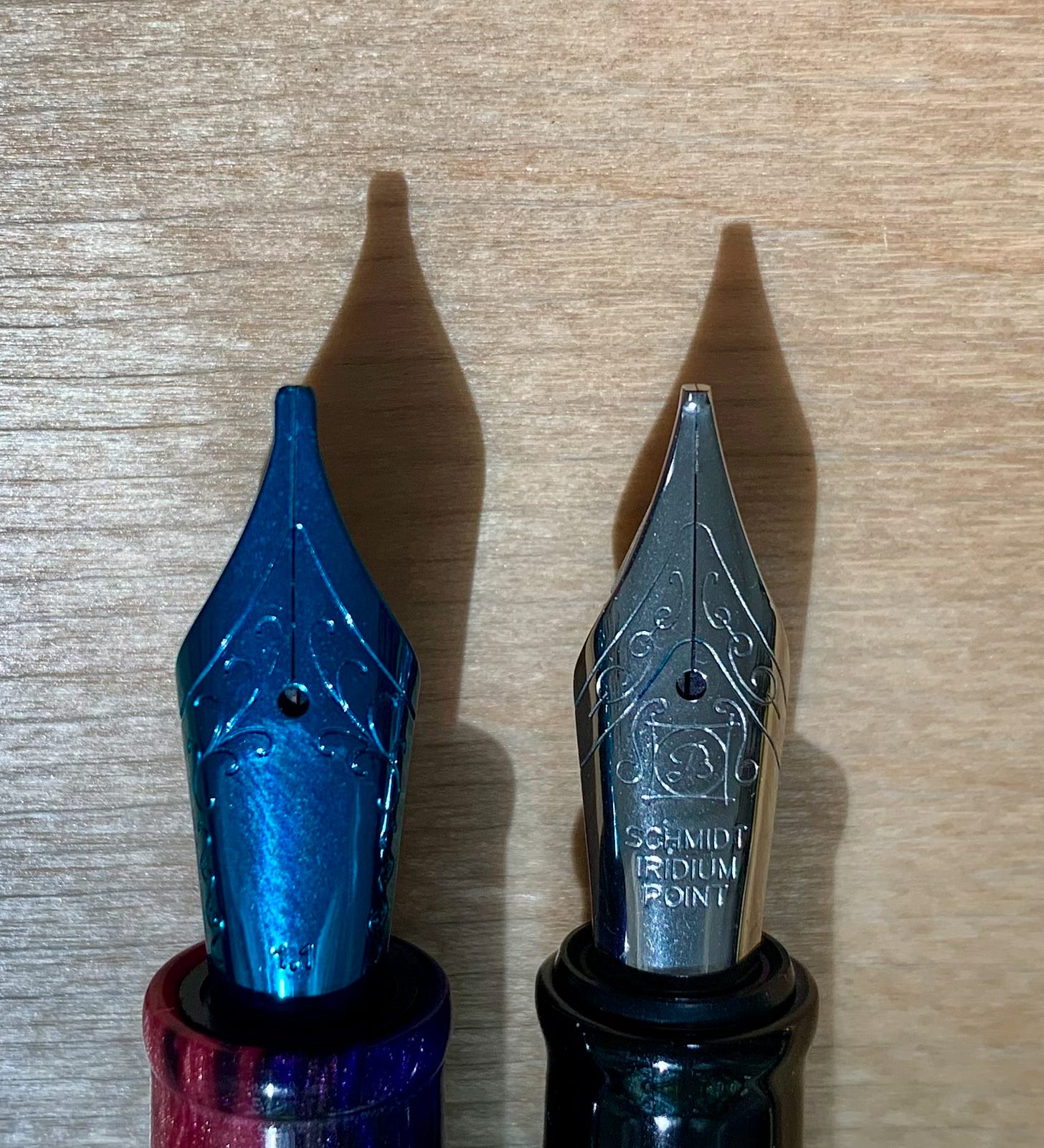A comprehensive guide to stub nibs
plus: a spirit of adventure
New to fine writing? You probably have questions about why some nibs are pointy and others look like tiny shovels. This post explains the tiny-shovel kind. It has been thoroughly researched by our world-class staff and so you should feel no need to fact-check any of it, including the part about Big Nib.
What’s a “stub” nib?
A “stub” nib is a specialized type of pen nib that you will become interested in once you have decided that using a fountain pen is, itself, no longer quirky enough for you. Known for its distinctive squared-off end, a stub is one of the two main types of specialty nibs and is used for East-coast lettering, diploma headings, and very aggressive poetry.
The other type is a “flex” nib, which is used for West-coast lettering, incomprehensible wedding invitations, and decorating household goods with the word “breathe.”
It is important that you decide which camp you fall into as soon as possible so that you can enjoy the camaraderie and protection of like-minded people—much like choosing a gang in prison, yes, but with higher stakes. It is equally important that you do not make the mistake of carrying a stub nib into flex territory or vice-versa unless you are specifically looking for trouble; the fountain pen community is still healing from the tragic events of the 2007 San Francisco Pen Show (“the war of the nibs”).
How is it made?
Despite their simple appearance, stub nibs are a marvel of metalsmithing, forged in the flames of Mount Doom by only the most skilled of artisans. Crafting one involves a complicated 102-step process that, if executed incorrectly, will both ruin the nib and generate a small amount of toxic waste. It is a process for trained professionals only.
…OR SO “BIG NIB” WANTS YOU TO BELIEVE.
In truth, any nib can be a stub nib if you have a pair of scissors and a spirit of adventure.
Any pair of scissors will do, but it’s a good idea to use the same pair you use to trim raw chicken and open cardboard boxes. This will add character and E. coli to your penmanship.
It takes a little bit of practice to get this right, so be sure to start with your favorite gold nibs as their softer composition will yield the cleanest cut. If you do it wrong and ruin all your nibs, your spirit of adventure was lacking and you might want to try a tamer hobby.
What are the types?
Stub nibs come in two main varieties: stabby and kinda round. The shadows in this picture do a good job of showing the difference.
The stabby kind (right) has sharp, crisp corners and creates a dramatic line contrast: super fat one way, hair-breadth the other. This is useful for calligraphy as well as for making fun little gouges in the paper. (Pro tip: do not give your nib-gouged paper to a blind friend and ask if you are “doing Braille.” You are not.)
The kinda-round kind (left) is much more common and comes with edges that are kinda round. If you buy a standard stub nib out of the box, this is what you have. It lets you write at a much faster pace without tearing the paper, but also looks less cool.
You will also sometimes see people get into finer distinctions here, offering precise definitions of stubs, cursive italics, formal italics, business-casual italics, and so on. This is like me trying to explain the difference between grindcore and powerviolence to my wife who does not like heavy metal: there are only like five people who can actually tell the difference and all the categories sound made-up anyway. Or, put otherwise: don’t worry about it!
A much more interesting distinction is size. Stub nibs can be categorized into three general size bands: Standard, Hahaha That’s Gigantic, and Gaslight.
The “standard” stub nib is 1.1mm in width at its broadest point. If you order a “stub” nib from most manufacturers, this is what you will get, and it can serve as a good all-purpose nib for section headings, signatures, and general writing if you are a giant with huge hands.
Stub nibs in the “Hahaha That’s Gigantic” category come with extremely wide nibs that push the boundaries of what a fountain pen can do—meaning, you often have to write pretty slow with one of these because they put down far more ink than a fountain pen feed can normally handle. Widely-available versions include a 1.9mm nib from LAMY and a 2.3mm from Kaweco, both of which are perfect for hand-lettering the flyer for your industrial band’s next show.
Finally, we have “Gaslight” stubs, which are about 50% the size of a regular stub nib—generally 0.5 to 0.7mm at their widest point. These nibs do not have the line variation of their larger brethren, but what they lack in visual drama they deliver in psychological warfare. That’s because these nibs are slim enough to be used in everyday writing, but their subtle variation adds enough flair to your penmanship to make other people ask how you make your handwriting look like that—to which you will answer “oh, I don’t know what you mean, it’s just how I write.” A perfect choice for those who love beautiful penmanship and deranging their coworkers alike, easily-available versions can be purchased from Super5 and Nemosine.
How do you use it?
There are two things to know when attempting to use a stub nib: the proper way to hold it, and the proper size of the script.
As to the first: start by warming up your hand, gripping the pen in an axe-handle position and making a stabbing motion. (This works best in crowded places like a bus or public library.) Next, and in contrast to the low angle of a typical fountain pen, you will want to hold the nib reversed and totally upright when you write. If the nib is making a “screech screech” noise and tearing a hole in the paper, you are doing it right.
As to script size, one must remember the 5X rule. This rule means the X-height of your handwriting should be 5 times the width of the nib. For example, if you are using a Standard stub, your x-height would be 5.5mm.
Writing smaller than this size is called “blackletter” because your lettering will look like a big pile of ink. This obviously looks cool, which is another reason it is called “blackletter” as that sounds pretty metal. Writing larger than 5x with a stub nib is called “why did you even bother using a stub that looks dumb.”
Where can I buy a stub?
At most pen shops and retailers, though precise tuning and the widest variety is sold at Stubby’s, a combination pet/stationery shop that specializes in calligraphy pens and munchkin cats. Tell them this blog sent you for a 10% discount them to say “I don’t know what that is” and then please comment below to confirm that I willed that shop into existence.









So what is your stance on flex stub nibs? Abominations? Olive branches in the great war?
I just bought my first stub and was definitely taken aback that no, I really can’t just do regular writing with it. But I’m getting the hang of it and enjoying it a lot for fancy/fun stuff.
What about architect nibs, tho?